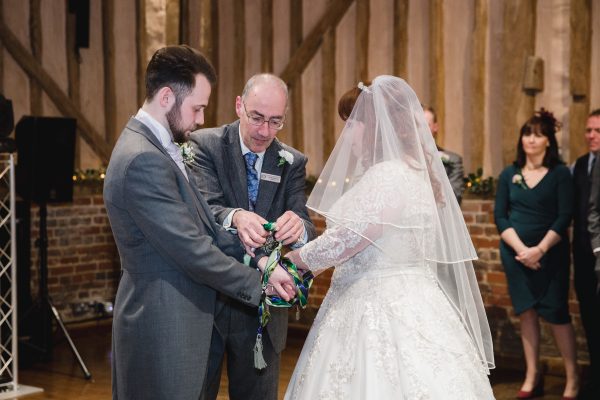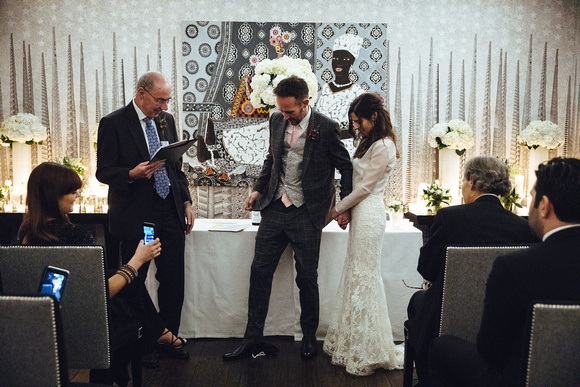If you’re looking for a personalised wedding ceremony, you might like to include a ritual. It can make such a difference.
“Ritual” may possibly sound a bit too religious for some, but it could be something as simple as both drinking from a Loving Cup, or presenting parents with a red rose.
You may never have considered a handfasting ceremony. Actually, you may not have heard of one, either!
Assuming that you are basically unfamiliar with a handfasting, here is a bit of information that may clarify things.
Example of a handfasting

Photo: louiedonovanphotography.co.uk
Briefly, and simply: the couple take each other’s hands – left in left, and so on. The celebrant ties their wrists together and says suitable, beautiful words. After a while, the hands are untied.
In its simplest form, that is a handfasting.
Incidentally, this ritual is the origin of the expression “tying the knot” and indeed “bonds of holy matrimony”.
Origins
The ceremony probably originated in Celtic times; however, it flourished in Europe until the mid 1700s. Up till then, few unions were sanctified in a religious building like a church. Rather, they were celebrated by a simple handfasting ceremony in which the two partners joined hands over the village anvil, in the fields or in the groves of trees. Today, we build upon this tradition.
The basics
The couple link and cross hands (normally right hand to right, and left to left) to form an infinity circle. Then, with a cord or ribbon (or ribbons), the wrists are symbolically tied and knotted, in a lovers’ knot.
The cords are then removed with the knots still in place. The couple will take the cord away with them and, ideally, it will be a permanent reminder of their vows.
Where does this happen?
Again, it depends, but many people prefer a quiet, open-air historic site that may be considered to be spiritual and preferably pagan – such as standing stones.
What about Stonehenge?
A civil celebrant, such as myself, can conduct a handfasting wedding or vow renewal in the Inner Circle at Stonehenge (normally around dawn or dusk), but this needs to be booked months in advance. However, places like Avebury, Old Sarum or the Rollright Stones might be more practical.
A handfasting can comprise an entire ceremony in itself, but is often one element among many.
Breaking the Glass

Photo: www.lyndseygoddard.com
Originally Jewish, this ritual is growing in popularity. There are many explanations for this. For example: it can recall the destruction of the Jerusalem Temple; serve as a symbolic reminder that things do break; and I have even heard that it is meant to be the last destructive thing to happen in the marriage.
Come what may, everybody enjoys shouting “Mazal tov!” when the deed is done!
Your civil celebrant will be able to help you learn more about rituals. Why not take advantage?
